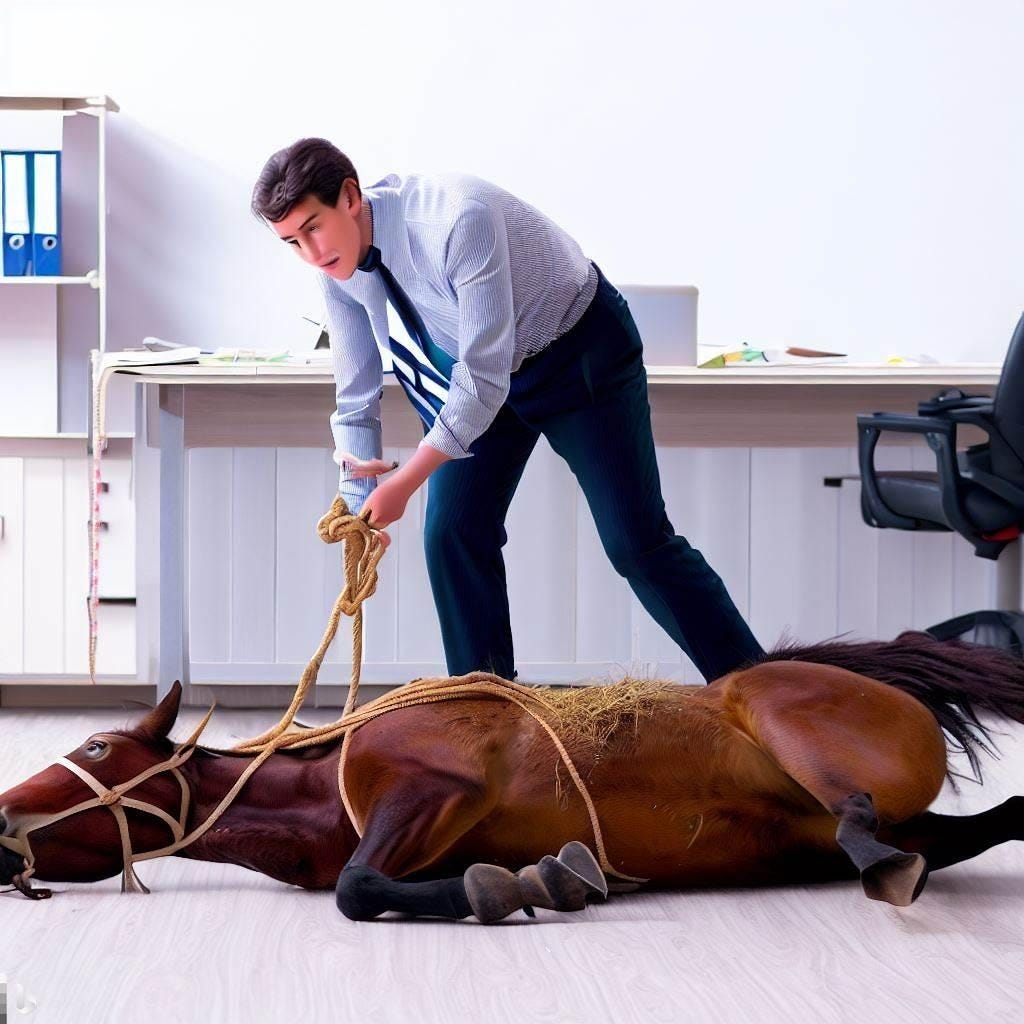It’s 2 o’clock.
The phrase "flogging a dead horse" paints a rather macabre image, but its underlying message is profound and timely. It metaphorically underscores the pointlessness of pursuing an unproductive course of action. Yet, despite the clarity of this metaphor, many contemporary industries continue to, figuratively speaking, ride their dead horses, and even worse, apply counterproductive tactics to manage them.
Let's explore how modern society often deals with its "dead horses" in less than effective ways:
Promote the Dead Horse: Instead of acknowledging the horse's state, some firms give the horse a new job title. Overnight, the dead horse becomes a "Strategic Business Unit" or an "Emerging Market Specialist." The only thing that changes is the nameplate on the office door.
Study the Dead Horse: This is where committees come in. Instead of burying the horse, a task force is established to study how the horse died, why it died, and how it could have lived longer. Meanwhile, the rot continues, stinking up the whole organisation.
Buy a Better Whip: Instead of seeking new ways to progress, industries invest in expensive tools to coax life out of the horse. "If only we had a more sophisticated whip," they lament, "the horse would be galloping by now."
Benchmark Other Dead Horses: To validate the continuous flogging, industries will point to other sectors. "Look at how the banking industry is dealing with their dead horse!" They fail to realise that the banking industry may be in as much denial as they are.
Reframe the Dead Horse: Here, the dead horse isn't really dead; it's just "pacing challenged" or "metabolically different." By reframing the issue, industries can delude themselves into thinking there isn't a problem.
Outsource the Dead Horse Management: If all else fails, they may consider paying someone else to deal with the dead horse. The outsourcing contract reads: "Reviving Dead Horses at Competitive Rates."
Change the Rider: Perhaps the horse isn't the problem at all. Maybe it's the person in the saddle. In this scenario, organisations choose to replace leaders or managers, hoping a new rider might coax life from the dead horse.
Declare the Dead Horse is Better Than No Horse: With this approach, organisations stick to their failing strategies because they feel that it's better than having no strategy at all.
Ride Two Horses at Once: Some organisations might decide that the answer is to find another horse - but instead of replacing the dead one, they attempt to ride both at the same time, inevitably stretching resources thin and achieving little.
Form a Quality Circle to Improve the Horse's Performance: In this scenario, organisations might create a group of people who perform the same function, to discuss their performance metrics and find ways of improving them - which does nothing to address the core issue if the strategy or product is fundamentally flawed.
Increase the Standards for Riding Dead Horses: Sometimes, organisations raise the qualifications needed to ride the dead horse. That way, they can blame the unqualified for their failures.
Hire Consultants to Ride the Dead Horse: Organisations may bring in highly paid consultants with esoteric expertise in "dead horse riding." They offer fancy reports and fresh jargon but seldom breathe life into the dead horse.
Declare That "Our Horse is Less Dead": By comparing their own dead horse to even deader horses, organisations can create the illusion of life or productivity.
Implement a Training Session to Increase our Riding Ability: Instead of changing the horse, organisations will invest in skill development programs to enhance the riders' ability. While training is important, it can't fix a fundamentally flawed situation.
In the end, whether it's promotion, studying, whipping, benchmarking, reframing, or outsourcing, these strategies overlook the simplest, most effective solution: dismount and find a live horse.
Ironically, it seems that modern industries are less interested in making progress than they are in developing innovative ways to convince themselves they're not riding a dead horse.
After all, a dead horse is easier to manage - it doesn't kick, doesn't need feeding, and never, ever bolts. The trick, it appears, is to remember to hold your nose.


